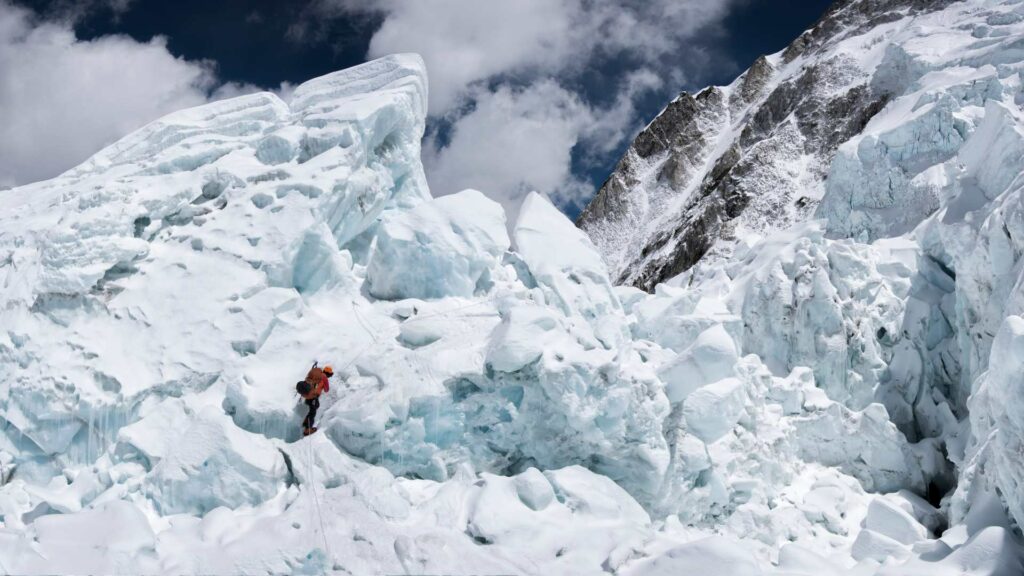The Enigmatic Tale of ‘Green Boots’ of Mount Everest
Mount Everest stands as both a testament to human ambition and a silent witness to profound tragedy. Among the many stories surrounding the Himalayas, the tale of “Green Boots” stands out as one of the most enigmatic and chilling. This name refers to a climber whose body became a grim landmark on the Northeast Ridge, symbolizing the inherent dangers of Everest. “Green Boots” remains a mystery that fascinates climbers and historians to this day. Reflecting Everest’s deadly allure and uncertainties that it carries with it.
The Haunting Presence of ‘Green Boots’
On Everest, one of the most chilling landmarks for climbers is “Green Boots.” Located along the Northeast Ridge, the body of an unidentified climber became an unavoidable waypoint for those making their way toward the summit. His bright green boots, contrasting sharply with the white snow and ice, served as a stark reminder of the mountain’s deadly challenges. Over the years, this spot has allowed climbers to pause and reflect before continuing their journey. Efforts to remove or cover the body have sparked ethical debates surrounding the risks of climbing the world’s tallest peak. Today, “Green Boots” remains a lasting symbol of the human cost of climbing Everest—a powerful reminder of the mountain’s unforgiving nature.
The Identity of ‘Green Boots’
For years, the identity of “Green Boots” has intrigued climbers and historians alike. His prominent location and distinctive green boots have made him a part of Everest’s lore. While several theories exist, the true identity of “Green Boots” remains unconfirmed, leaving much to speculation. Climbers embarking on the iconic EBC Trek (Everest Base Camp Trek) often hear tales of Green Boots, as his story is woven into the fabric of Everest’s history. The Everest region, with its breathtaking landscapes and treacherous trails, is a place where triumph and tragedy coexist, and Green Boots stands as a testament to the mountain’s unforgiving nature.
Tsewang Saman: A Controversial Theory
A widely accepted theory suggests that “Green Boots” is Tsewang Paljor, an Indian climber who perished during the 1996 Everest disaster. Part of an Indo-Tibetan Border Police group, Paljor was separated from his team during a violent storm. He took shelter in a small cave but died from exposure and lack of oxygen. His boots, which resemble the green ones found on the body, have led many to link him to “Green Boots.” However, without concrete evidence, such as DNA testing, the theory remains speculative. Bodies of other climbers, lost in similar conditions, make identifying “Green Boots” even harder.
The Unsolved Mystery
Despite the widespread theory that “Green Boots” is Tsewang Paljor, questions remain. Why was he separated from his team? Could the body belong to another climber, lost during the same storm or on a different expedition? These unanswered questions keep the story of “Green Boots” alive, adding to the haunting mystery of Everest’s untold secrets.
The Significance of ‘Green Boots’ in Mountaineering
“Green Boots” is more than a tragic figure—he’s a powerful symbol of Everest’s beauty and danger. To climbers, he represents the narrow margin between success and survival at high altitudes. “Green Boots” has sparked discussions about the risks of mountaineering, the ethics of leaving remains on the mountain, and the emotional toll on those who encounter it. More than just a marker, it highlights the relentless struggle between human ambition and nature’s raw power. “Green Boots” serves as a grim reminder to climbers to respect the mountain, prepare thoroughly, and value the camaraderie that is key to any successful ascent.
A Grim Landmark
For over two decades, “Green Boots” was a prominent marker on the Northeast Ridge. Resting in a limestone alcove, his body became a critical checkpoint for climbers to assess their progress. Expeditions often referred to him as a navigational landmark—his functional role born from tragedy. Yet, his presence cast a shadow over the Everest experience. “Green Boots” silently witnessed the struggles and sacrifices of those attempting to reach the summit, compelling climbers to reflect on the risks and life-altering decisions they were making.
However, Green Boots is just one of many stories that highlight the perilous nature of the mountain. Nearby, the hauntingly named “Sleeping Beauty Everest“, tells the story of Francys Arsentiev, an American climber who tragically lost her life during her descent in 1998. Her story, like that of Green Boots, serves as a poignant reminder of the risks faced by those who dare to challenge the mountain.
Another chilling site on Everest is “Rainbow Valley Everest,” a section of the mountain named for the colorful down jackets of climbers who have perished there. This area, often described as a graveyard in the sky, is a stark contrast to the natural beauty of the surrounding landscape
Ethical Considerations
The visibility of “Green Boots” sparked intense debates about the ethics of leaving bodies on Everest. Recovering remains from the mountain is incredibly difficult due to harsh conditions and logistical challenges. Some argue that leaving bodies in plain view is disrespectful to the deceased and their families. Others believe these remains, including “Green Boots,” are an integral part of Everest’s history, serving as a poignant warning for future climbers. This ethical dilemma extends beyond individual cases, highlighting concerns about the commercialization of Everest and its growing number of casualties.
The Tragic Story of David Sharp

While “Green Boots” has been a haunting figure on Everest for decades, the landmark gained even more attention in 2006 with the tragic death of David Sharp. The British climber, attempting a solo ascent of Everest, was found in a hypothermic state near “Green Boots” by multiple expeditions. Despite being alive, he was unresponsive, and climbers continued past him, unable or unwilling to mount a rescue. Sharp ultimately succumbed to the extreme conditions.
His death sparked a global ethical debate: Should climbers abandon their own summit bids to assist those in distress? Many argued that Everest’s harsh conditions make rescues nearly impossible at such altitudes, while others condemned the “every climber for themselves” mentality that had developed due to the mountain’s commercialization. Sharp’s story underscored the brutal reality of Everest—where survival often takes precedence over saving others.
The Legacy of ‘Green Boots’
The story of “Green Boots” has significantly impacted how climbers approach Everest. His tale serves as a cautionary reminder of the mountain’s merciless nature. As a result, expeditions today prioritize safety protocols, teamwork, and comprehensive preparation—citing tragedies like that of “Green Boots” as motivators for better planning.
Impact on Climbing Expeditions

“Green Boots” continues to shape how climbers prepare for expeditions on Everest. His body in the limestone alcove serves as a chilling reminder of the dangers of high-altitude climbing. For many climbers, it forces a moment of reflection on their physical and mental preparedness before advancing further.
The legacy of “Green Boots” has also influenced climbing strategies. Climbers now focus on safety and careful planning, understanding that Everest’s risks demand constant awareness. They monitor weather conditions closely, recognize when to turn back, and emphasize the importance of human life over the summit. “Green Boots” reminds us of the consequences that follow when safety is compromised in the pursuit of glory.
Ongoing Discussions
Though “Green Boots” has reportedly been moved or covered in recent years to preserve dignity, his story still resonates. It has become a cornerstone of ethical debates, particularly about the responsibility of climbers to assist those in distress. Additionally, “Green Boots” has contributed to growing concerns over the environmental impact of human activity on Everest. As temperatures rise and traffic increases, more bodies and debris are exposed, sparking discussions about the mountain’s future. The legacy of “Green Boots” continues to provoke questions about the true cost of conquering the world’s highest peak.
Reflecting on the Legacy of ‘Green Boots’
“Green Boots” remains one of the most poignant and disturbing chapters in Everest’s history. While his identity may never be confirmed, his presence as a silent witness is undeniable. His story forces climbers to confront their own mortality, raising crucial questions about responsibility, respect, and ambition in the face of Everest’s challenges. As climbers continue to scale the peak, the legacy of “Green Boots” endures, serving as a haunting reminder of the mountain’s immense power and the human lives intertwined with its icy slopes.
